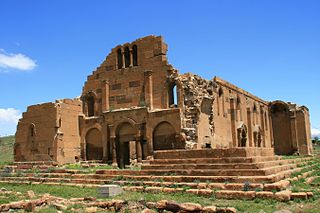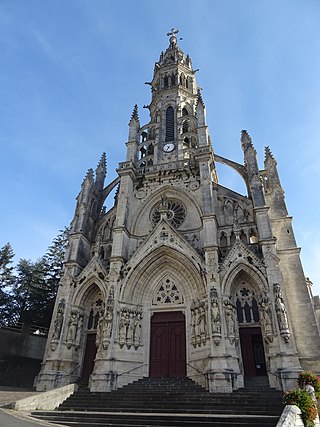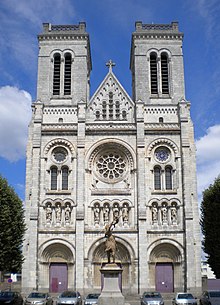
Rennes is a city in the east of Brittany in northwestern France at the confluence of the rivers Ille and Vilaine. Rennes is the prefecture of the region of Brittany, as well as the Ille-et-Vilaine department. In 2017, the urban area had a population of 357,327 inhabitants, and the larger metropolitan area had 739,974 inhabitants. The inhabitants of Rennes are called Rennais (masculine) or Rennaises (feminine) in French.

The Basilica of Saint-Denis is a large former medieval abbey church and present cathedral in the commune of Saint-Denis, a northern suburb of Paris. The building is of singular importance historically and architecturally as its choir, completed in 1144, is widely considered the first structure to employ all of the elements of Gothic architecture.

Nantes is a city in Loire-Atlantique of France on the Loire, 50 km (31 mi) from the Atlantic coast. The city is the sixth largest in France, with a population of 320,732 in Nantes proper and a metropolitan area of nearly 1 million inhabitants (2020). With Saint-Nazaire, a seaport on the Loire estuary, Nantes forms one of the main north-western French metropolitan agglomerations.

The Basilica of Sacré Coeur de Montmartre, commonly known as Sacré-Cœur Basilica and often simply Sacré-Cœur, is a Roman Catholic church and minor basilica in Paris dedicated to the Sacred Heart of Jesus. It was formally approved as a national historic monument by the National Commission of Patrimony and Architecture on December 8, 2022.

May 23 - Eastern Orthodox Church calendar - May 25

The Basilica of Saint-Sernin is a church in Toulouse, France, the former abbey church of the Abbey of Saint-Sernin or St Saturnin. Apart from the church, none of the abbey buildings remain. The current church is located on the site of a previous basilica of the 4th century which contained the body of Saint Saturnin or Sernin, the first bishop of Toulouse in c. 250. Constructed in the Romanesque style between about 1080 and 1120, with construction continuing thereafter, Saint-Sernin is the largest remaining Romanesque building in Europe. The church is particularly noted for the quality and quantity of its Romanesque sculpture. In 1998 the basilica was added to the UNESCO World Heritage Sites under the description: World Heritage Sites of the Routes of Santiago de Compostela in France.

The Church of Saint George in the city of Lod is a Greek Orthodox church containing a sarcophagus venerated as the tomb of the fourth-century Christian martyr Saint George.

The Diocese of Nantes is a Latin Church diocese of the Catholic Church in Nantes, France. The diocese consists of the department of Loire-Atlantique. It has existed since the 4th century. It is now suffragan of the Archdiocese of Rennes, Dol, and Saint-Malo, having previously been suffragan to the Archdiocese of Tours. Its see is Nantes Cathedral in the city of Nantes.

Yererouk, also Yereruyk or Ererouk, is an ancient Armenian church near the village of Anipemza in the Shirak Province of Armenia. Yererouk was built on a plateau near the Akhurian River, which defines the frontier with Turkey, about 5 km southeast of the ancient city of Ani.

Donatian and Rogatian were two brothers, martyred in Nantes during the reign of Roman Emperor Maximian, around 288–290, for refusing to deny their faith. They are also known as les enfants nantais. Their feast day is 24 May.

Charles-Auguste Lebourg was a French sculptor, best known for the sculptural design of the Wallace fountains, which are found in virtually every quarter of Paris and in various cities throughout the world. He also created numerous statues and busts in bronze and marble, winning recognition at various Salons and World's Fairs throughout the latter half of the nineteenth century. His work is on display at the Musée d'Orsay in Paris and the Fine Arts Museum in Nantes, as well as various parks and cemeteries in France.
Hoël I of Brittany was an illegitimate son of Alan II and Judith. He was Count of Nantes and Duke of Brittany from 960 to 981.
Émilien of Nantes was a French religious leader who was canonized by the church as a martyr for dying in a fight against the Saracens in Burgundy in 725 AD. No written records earlier than the 16th century survive, and there are no records of a Bishop Émilien of Nantes. The legend probably has its roots in a real clash with the Saracens, who were present in the region at the time, but has been considerably embroidered.

The Church of St. Similien, Nantes is an ancient church, in the Hauts-Pavés district of Nantes, France.

The Basilica of Saint-Quentin, formerly the Collegiate Church of Saint-Quentin is a Catholic church in the town of Saint-Quentin, Aisne, France. There have been religious buildings on the site since the 4th century AD, which were repeatedly destroyed and rebuilt during the Early Middle Ages. The present basilica was constructed in stages between the 12th and 15th centuries. It was severely damaged in World War I (1914–18), and was only reopened in 1956 after extensive reconstruction.
Guerech of Brittany, was Count of Nantes and Duke of Brittany from 981 to 988.

The Basilica of Saint Severinus is a church built in Bordeaux at the dawn of the 11th century.

Basilica of Notre-Dame des Enfants is a minor basilica located in Châteauneuf-sur-Cher, France. The basilica is dedicated to Our Lady of the Children and is the seat of the Archbishop of Bourges. Built from 1869 until 1879, it is largely in the Neo-Gothic architectural style and was constructed at about the same time as Basilica of Notre-Dame de Fourvière.

The Basilica of Saint-Sauveur de Dinan is a Roman Catholic church situated in Dinan, France. Historically, it is one of the two parish churches in the town, the other being Saint-Malo.

















